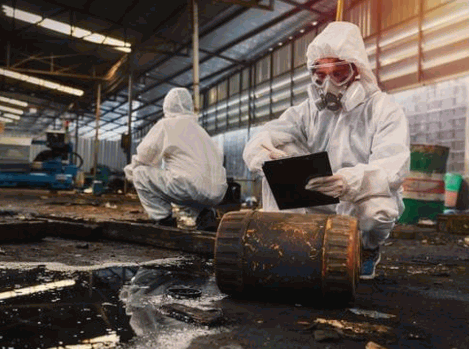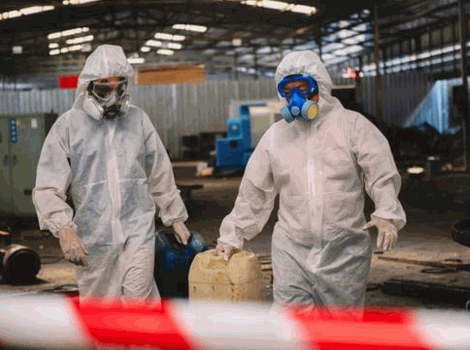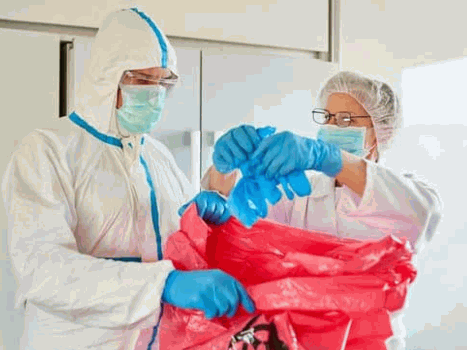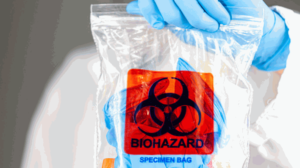Biohazards represent significant risks to health and safety, encompassing a variety of biological materials and environmental specimens that can jeopardize the well-being of humans, animals, and the environment. It is essential for individuals working in healthcare, laboratories, or other high-risk environments to comprehend the different types of biohazards, the routes of exposure, and the potential health effects associated with these pathogenic microorganisms and infectious substances. This article provides an overview of how to identify and manage biohazardous materials, such as microbiological waste and pathological waste, while also outlining the critical regulations and safety measures necessary for their proper handling. Furthermore, it offers guidance on effectively responding to biohazard emergencies to ensure the protection of oneself and others, as per ANSI standards and CDC guidelines.
What Is A Biohazard?
A biohazard is defined as biological materials that present a potential threat to the health of living organisms, particularly humans. This category encompasses infectious substances, biological agents, and pathogenic microorganisms, as initially identified by Charles Baldwin at Dow Chemical Company.
Identified by the biohazard symbol, these materials require stringent handling procedures to minimise exposure risks to health safety. Biohazards can arise from a variety of sources, including human blood, animal waste, and environmental specimens, which may contain pathogens or biotoxins that pose significant health risks.
These health risks include the transmission of diseases such as HIV and viral infections, including Ebola and Marburg viruses.

What Are The Types Of Biohazards?
Biohazards are classified into four distinct levels based on the potential risks they pose to human health and the environment. This classification ranges from Biohazard Level 1, which presents minimal risk, to Biohazard Level 4, which involves highly dangerous pathogens requiring the utmost level of containment. Each level is defined by specific criteria related to laboratory practices, safety training, and the necessary equipment to manage biological agents effectively.
These classifications are essential for ensuring that laboratories operate under appropriate safety protocols, thereby protecting not only the staff but also the surrounding community. A comprehensive understanding of the specifics of each biosafety level and adherence to Environmental Health and Safety standards is crucial for implementing effective risk management strategies. Below is a brief overview of each biohazard level and their implications:
- Biohazard Level 1: Involves agents such as Bacillus subtilis, which are typically non-pathogenic. Safety practices necessitate general laboratory safety training.
- Biohazard Level 2: Includes pathogens such as Escherichia coli (certain strains) that can cause mild disease. Enhanced training and equipment are required for this level.
- Biohazard Level 3: Pertains to agents like Mycobacterium tuberculosis, which can cause serious illness. This level mandates specialised training and containment practices.
- Biohazard Level 4: Represents the highest risk pathogens, including the Ebola virus, which require maximum containment. Only personnel with advanced training are permitted to work with these agents.
Adhering to these stringent biosafety regulations is paramount for maintaining a safe laboratory environment, preventing potential outbreaks, and ensuring that research is conducted in a responsible and ethical manner.
What Are The Risks Of Exposure To Biohazards?
Exposure to biohazards poses significant health risks to individuals who come into contact with contaminated biological waste, infectious materials, or pathogenic microorganisms. The risk of disease transmission escalates considerably when dealing with biological agents such as HIV or environmental specimens that may contain biotoxins.
It is essential for health professionals, laboratory personnel, and waste management staff who handle biological materials, including organic material, to understand the associated exposure risks. Failure to implement adequate precautions can result in serious health consequences.

What Are The Common Biohazard Exposure Routes?
Common routes of biohazard exposure include direct contact with infectious substances, inhalation of airborne pathogens, and contamination through cuts or abrasions. Each of these exposure pathways can pose significant health risks.
Understanding these routes is essential for the implementation of effective health and safety measures designed to protect individuals from biological agents found in various environments, such as laboratories, healthcare facilities, and waste management sites managed by Environmental Health and Safety departments.
In workplaces where biological materials are handled, it is imperative to identify situations that may present risks. For instance, laboratory technicians often interact with potentially infectious samples, while healthcare professionals may encounter bodily fluids that could result in exposure. Similarly, individuals working in waste management may come into contact with contaminated items.
Preventive measures should include:
- Wearing appropriate personal protective equipment (PPE), such as gloves and masks, to limit exposure.
- Implementing safety protocols, including the proper disposal of biohazard waste.
- Providing regular training for staff on risk recognition and adherence to emergency procedures.
By cultivating a culture of safety and awareness, organisations can substantially reduce the risk of biohazard exposure and foster a healthier workplace environment.
What Are The Potential Health Effects Of Exposure To Biohazards?
The potential health effects associated with exposure to biohazards can vary significantly, ranging from mild infections caused by pathogenic microorganisms to severe illnesses resulting from exposure to biotoxins or infectious waste. Occupational exposure may lead to chronic health issues or even fatal diseases, particularly in instances involving viral pathogens such as HIV or highly contagious agents like the Ebola virus or Lassa fever virus.
It is crucial to acknowledge that individuals working in sectors such as healthcare, laboratories, and environmental services may be at an increased risk for these adverse health effects. For example, exposure to biological agents such as Hantavirus can lead to respiratory syndromes, while contact with specific bacteria, such as Brucella, may result in long-term health complications, including arthritis or endocarditis. Additionally, workers in these environments should be aware of potential exposure to the Lassa fever virus.
Those who handle contaminated materials may be susceptible to developing:
- Chronic respiratory diseases
- Neurological disorders
- Gastrointestinal conditions
These long-term health implications underscore the necessity for stringent safety protocols in occupational settings to effectively minimise exposure risks and safeguard the health of workers.

How To Identify And Handle Biohazardous Materials?
Identifying and managing biohazardous materials necessitates thorough safety training and strict adherence to established handling procedures to ensure health and safety.
Proper identification involves recognizing the biohazard symbol, understanding the types of biological waste generated, and being aware of the specific biosafety level associated with the materials being handled. According to CDC guidelines, this understanding is integral to maintaining a safe work environment.
Implementing effective protocols is essential to minimise exposure risks and ensure the safe disposal of infectious waste and other biological materials.
What Are The Proper Precautions For Handling Biohazards?
To safely manage biohazards, it is imperative to implement appropriate precautions, which include the use of personal protective equipment (PPE), training on exposure risks, and adherence to established handling procedures for biological agents. These precautions are essential for safeguarding individuals from potential health risks associated with direct contact or aerosol exposure to harmful biological materials.
Additionally, attentiveness to the environment in which biological materials are processed is of utmost importance. Regular application of effective disinfecting methods is necessary to ensure that all surfaces and equipment are sanitised, thereby minimising contamination risks.
When selecting personal protective equipment (PPE), it is crucial to prioritise the appropriate gear based on the specific type of biohazard being handled. Commonly recommended PPE includes:
- Gloves: sturdy and impervious
- Face shields or goggles: to protect against splashes
- Lab coats or gowns: providing a barrier against skin contact
- Respirators: to guard against the inhalation of harmful agents
The significance of diligent hygiene practices, such as regular handwashing and proper waste disposal, cannot be overstated. In conjunction with these measures, organisations must emphasise the importance of emergency procedures to ensure rapid and effective responses to accidental exposure or spills.
Furthermore, regular safety training sessions and assessments are vital to ensure that all personnel remain informed about best practices and are aware of the most recent protocols concerning biohazard management.

How To Properly Dispose Of Biohazardous Waste?
Proper disposal of biohazardous waste is essential for preventing environmental contamination and safeguarding public health. This process requires strict adherence to established disposal procedures for infectious waste and other biological materials, including biological hazard materials such as human blood and microbiological waste.
The multi-step process involves understanding the various container types suitable for different waste categories. For instance, sharps containers are specifically designed for needles and blades, while leak-proof bags are intended for solid waste. It is imperative that all containers are clearly labelled with biohazard symbols and descriptions of the waste type to minimise risks during handling, ensuring compliance with ANSI standards.
Subsequently, it is vital to employ approved treatment methods, such as autoclaving or incineration, to neutralise the hazardous properties of these materials, including pathological waste and organic material commonly found in healthcare settings.
To ensure effective management of biohazardous waste, it is recommended to:
- Stay informed of the latest regulatory compliance requirements and environmental health considerations.
- Engage in regular training programmes for staff involved in waste handling.
- Conduct periodic audits to ensure adherence to safety practices and regulations.
Ultimately, these measures not only ensure compliance with local and national guidelines but also play a vital role in promoting a safe and sustainable environment for all.
What Are The Regulations For Dealing With Biohazards And Biohazard Levels?
Regulations governing the management of biohazards are established by authoritative organisations such as the Centres for Disease Control and Prevention (CDC), the Occupational Safety and Health Administration (OSHA), and the Environmental Protection Agency (EPA). These guidelines are designed to ensure the safe handling, disposal, and management of biological agents, such as the HIV virus, thereby safeguarding public health and the environment.
The regulations set forth standards for biosafety practices across various sectors, including healthcare, research, and waste management. These standards address the challenges posed by different biohazard levels, from Biohazard Level 1 to Biohazard Level 4, each with specific containment and safety requirements.

What Are The Occupational Safety And Health Administration (OSHA) Regulations?
The Health and Safety Executive (HSE) enforces regulations that govern the safe handling and exposure to biohazards in the workplace, underscoring the necessity for comprehensive safety training and protocols to safeguard employee health and safety.
These regulations delineate the responsibilities of employers to provide a secure working environment when managing biological agents and hazardous materials. To fulfil these obligations, employers must ensure that employees receive rigorous safety training specifically tailored to the risks associated with biohazard exposure. This training encompasses not only correct handling procedures but also emergency response actions in the event of an incident. Monitoring exposure is essential to identify potential hazards early, facilitating prompt corrective measures.
Employers are required to document and communicate any potential exposures effectively. Additionally, incident reporting must be conducted without delay, thoroughly documenting any exposure events to enhance understanding of associated risks. This practice is part of a comprehensive Environmental Health and Safety programme.
Non-compliance with these regulations can result in severe penalties, including fines and heightened scrutiny from regulatory bodies. Ultimately, prioritising safety and adhering to HSE regulations transcends mere compliance; it fosters a culture of safety in which employees feel valued and secure within their workplace environment.
What Are The Environmental Protection Agency (EPA) Regulations?
The Environment Agency (EA) establishes regulations for the management and disposal of biohazardous materials to protect environmental safety and public health, emphasising the appropriate treatment and disposal of hazardous biological waste.
These regulations not only safeguard public well-being but also outline comprehensive procedures for the segregation, transportation, treatment, and disposal of biohazardous materials originating from healthcare facilities, laboratories, and research institutions. Through the implementation of stringent guidelines, the EA ensures that the handling of such materials is conducted meticulously to prevent contamination of land, water, and air.
Adherence to these regulations is critical for mitigating environmental risks associated with biohazards, as non-compliance can result in severe consequences for both ecosystems and communities.
Ensuring compliance with these protocols is essential for promoting sustainable practices, thereby fostering a safer environment for future generations. These protocols are aligned with Biosafety Level requirements. Key components of compliance include:
- Proper segregation of waste
- Safe transportation methods
- Effective treatment processes
- Environmental monitoring efforts

What Are The Safety Measures For Working With Biohazards?
Safety measures for working with biohazards encompass the consistent implementation of personal protective equipment (PPE), strict adherence to established handling procedures, and continuous health and safety training to safeguard individuals from exposure to biological agents.
These measures are essential for mitigating the risks associated with infectious substances and for maintaining a safe working environment.
What Personal Protective Equipment (PPE) Is Required?
Personal protective equipment (PPE) is essential when working with biohazards, as it provides a critical barrier between individuals and biological agents that may pose health risks. This is especially crucial when dealing with high-risk agents like the Ebola virus, Marburg virus, and Lassa fever virus.
Given the diverse nature of biohazards, it is imperative to understand that the selection of PPE must be tailored to specific biohazardous situations. For instance, when addressing Level 1 and Level 2 biohazards, standard gloves and surgical masks may be adequate. However, when handling more serious pathogens classified at Level 3 and above, it is necessary to utilise full-body suits, powered air-purifying respirators, and face shields.
Proper fit is crucial, as an improper fit can compromise the efficacy of the equipment, thereby leaving individuals vulnerable to exposure. Additionally, diligent maintenance of PPE is equally important to ensure that its protective qualities remain intact.
Regular training and assessment of the tasks being performed are vital to equip workers with the knowledge needed to select appropriate PPE based on specific risks, thereby effectively guarding against contamination.

How To Properly Clean And Decontaminate After Exposure To Biohazards?
Proper cleaning and decontamination following exposure to biohazards are essential to prevent the spread of infectious agents and safeguard public health. This process requires the use of appropriate cleaning agents and adherence to established safety protocols to effectively neutralise and remove biological contaminants from surfaces and materials.
Implementing a comprehensive protocol is vital to minimising all potential risks. It is important to assess the situation and identify the specific type of biohazard present, as different organisms may necessitate tailored responses. Adhering to established cleaning guidelines ensures the utilisation of suitable agents, which often include disinfectants that are effective against viruses, bacteria, and fungi.
The following steps should be undertaken:
- Don personal protective equipment (PPE), such as gloves, masks, and goggles.
- Clear the area of unnecessary personnel to mitigate exposure risks.
- Employ a detergent solution for initial cleaning, followed by a specialised disinfectant to guarantee thorough decontamination.
- Focus on high-touch surfaces, as these are frequently the primary vectors for contamination.
Maintaining documentation of the cleaning process can enhance accountability and provide assurance of safety measures in the event of future incidents.
Learn about: Best Way To Clean Bat Droppings
How To Respond To A Biohazard Emergency?
Responding to a biohazard emergency necessitates a well-structured response plan that incorporates clear protocols for identifying the threat, mitigating exposure risks, and ensuring the safety of all individuals involved.
Along with these initial protocols, a comprehensive approach must include detailed steps for assessment, containment, and a systematic process for reporting incidents. By promptly assessing the situation, responders can ascertain the level of hazard and the appropriate actions required. Subsequently, immediate containment measures should be implemented to prevent the spread of harmful agents. Engaging in thorough reporting procedures is essential for documenting the incident and facilitating post-event analysis, thereby ensuring that lessons learned are incorporated into future training.
The importance of training and preparedness cannot be overstated; effective management of biohazard emergencies relies on routine drills and updates to safety protocols. Such preparedness cultivates a culture of safety and vigilance, equipping personnel to act decisively in the face of a crisis. The principles laid out by Charles Baldwin and the Dow Chemical Company provide foundational guidelines for establishing these safety protocols.








